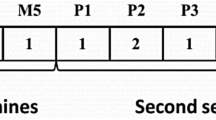Abstract
The aim of a cellular manufacturing system is to group parts that have similar processing needs into part families and machines that meet these needs into machine cells. This paper addresses the problem of grouping machines with the objective of minimizing the total cell load variation and the total intercellular moves. The parameters considered include demands for number of parts, routing sequences, processing time, machine capacities, and machine workload status. For grouping the machines, an ant colony system (ACS) approach is proposed. The computational procedure of the approach is explained with a numerical illustration. Large problems with up to 40 machines and 100 part types are tested and analyzed. The results of ACS are compared with the results obtained from a genetic algorithm (GA), and it is observed that its performance is better than that of GA.
Similar content being viewed by others
References
Opitz H (1970) A classification system to describe work pieces. Pergamon, New York
Burbidge L (1963) Production flow analysis. Prod Eng 42:742
King JR (1980) Machine-component grouping in production flow analysis: an approach using a rank order-clustering algorithm. Int J Prod Res 18:213–239
Chan HM, Milner DA (1982) Direct clustering algorithm for group formation in cellular manufacture. J Manuf Sys 1:64–76
McCormick WT, Schweitzer RJ, White TW (1972) Problem decomposition and data reorganization by clustering techniques. Oper Res 20:993–1009
McAuley J (1972) Machine grouping for efficient production. Prod Eng 15:53–57
Seifoddini H, Wolfe P (1990) Application of similarity coefficient methods in GT. IIE Trans 18(3):271–277
Prabhakaran G (2001) Clustering and machine cell formation for cellular manufacturing systems. PhD thesis, Bharathidasan University, Tiruchirappalli, Tamil Nadu, India
Srinivasan G, Narendran TT, Mahadevan B (1990) Assignment model for the part families in Group technology. Int J Prod Res 29:463–478
Rajagopalan R, Batra JL (1975) Design of cellular production systems – a graph theory approach. Int J Prod Res 13:567–579
Boctor FF (1991) A linear formulation of the machine-part cell formation problem. Int J Prod Res 29:343–346
Vakharia AJ, Chang YL (1997) Cell formation in group technology: a combinatorial search approach. Int J Prod Res 35:2025–2043
Steudle H, Ballakur A (1987) A dynamic programming based heuristic for machine grouping in manufacturing Cell Formation. Comput Ind Eng 12(3):215–22
Shafer S, Rogers D (1991) A goal programming approach to the cell formation problem. J Oper Manage 10(1):28–43
Chen WH, Srivstava B (1994) Simulated annealing procedures for forming machine cell in-group technology. Eur J Oper Res 71:100–111
Venugopal V, Narendran TT (1992a) Cell formation in manufacturing systems through simulated annealing: an experimental evaluation. Eur J Oper Res 63:409–422
Venugopal V, Narendran TT (1992b) A genetic algorithm approach to the machine–component grouping problems with multiple objectives. Comput Ind Eng 22:469–480
Logendran R, Ramakrishna P (1993) Manufacturing cell formation in the presence of lot splitting and multiple units of the same machine. Int J Prod Res 31:657–693
Basu A, Hyer N, Shtub A (1987) An expert system base on approach to manufacturing cell design. Int J Prod Res 25(5):639–665
Chow W, Hawaleshka O (1993) A novel machine grouping and knowledge based approach for cellular manufacturing. Eur J Oper Res 69:357–372
Singh N, Rajamaani D (1996) Cellular manufacturing systems: design planning and control. Chapman & Hall, New York
Selim HM, Askin RG, Vakharia AJ (1998) Cell formation in group technology: evaluation and directions for future research. Comput Ind Eng 34(1):3–20
Chen C, Cotruvo N, Back (1995) A simulated annealing solution to the cell formation problem. Int J Prod Res 33(9):2601–2614
Guptha Y, Guptha M, Kumar A, Sundram C (1995) Minimization of total intercell and intra cell moves in cellular manufacturing: a genetic algorithms. Int J Comput Integr Manuf 8(2):92–101
Joines JA, Culbrethand CT, King RE (1996) Manufacturing cell design: an integer programming model employing genetic algorithms. IIE Trans 28:69–85
Logendran R, Ramakrishnanand P, Srikandarajah C (1994) Tabu search based heuristics for cellular manufacturing system in the presence of alternative process plans. Int J Prod Res 32(2):273–297
Dorigo M, di Caro G, Gamberdella LM (1999) Ant algorithms for discrete optimization. Artif Life 5(3):137–172
Patrick R, McMullen (2001) An ant colony optimization approach to address a jit sequencing problem with multiple objective. Artif Intell Eng 15:309–317
Dorigo M, Colorni A, Maniezzo V (1992) An investigation of some properties of an ant algorithm. In: Manner R, Manderick B (eds) Proceedings of the conference on parallel problem solving from nature, Brussels, Elsevier, Amsterdam, pp 509–520
Dorigo M, Gamberdella LM (1997) Ant colony system: a cooperative learning approach to the traveling salesman problem. IEEE Trans Evol Comput 1(1):53–66
Stützle T, Dorigo M (1999) Ant colony algorithms for quadratic assignment problem: new ideas in optimization, McGraw Hill, New York
Den Besten M, Stutzle T, Dorigo M (2000) An ant colony optimization application to the single machine total weighted tardiness problem. In: Dorigo M, Middendorf M, Stützle T (eds) Proceedings of ANTS’2000 – from ant colonies to artificial ants: second international workshop on ant algorithms, Brussels, Belgium, 2000, pp 39–42
Jayaraman VK, Kulkarni BD, Karale S, Shalokar P (2000) Ant colony frame work for optimal design and scheduling of batch plants. Int J Comput Chem Eng 24:1901–1912
A workload based model for minimizing total intercell and intracell moves in cellular manufacturing. Int J Prod Res 29:375–390
Author information
Authors and Affiliations
Corresponding author
Rights and permissions
About this article
Cite this article
Prabhaharan, G., Asokan, P., Girish, B. et al. Machine cell formation for cellular manufacturing systems using an ant colony system approach. Int J Adv Manuf Technol 25, 1013–1019 (2005). https://doi.org/10.1007/s00170-003-1927-0
Received:
Accepted:
Published:
Issue Date:
DOI: https://doi.org/10.1007/s00170-003-1927-0




